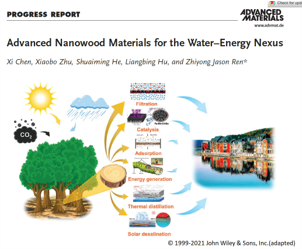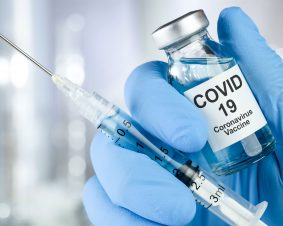 >
Spotlight September 2021: Wood, the raw material of the future?
>
Spotlight September 2021: Wood, the raw material of the future?
One of the greatest challenges facing humanity is to produce clean drinking water under the given circumstances of global warming, population growth and increasing littering. In September, we would like to present a review article that believes one approach to solve this problem is the use of nanoscale wood. In the review, “Advanced Nanowood Materials for the Water-Energy Nexus,” published in the journal Advanced Materials, methods for using wood for water treatment are outlined based on the structure of wood, bottom up or top down. Using the approaches described, wood can be used for water purification, desalination, or chemical removal.
Many examples are shown of how the basic building block of wood, cellulose (a natural polymer), can be processed into nanofibers or polymer matrices, enabling filtration of ultra-small particles.
In contrast, top-down approaches preserve the fundamental structure of wood. For example, naturally occurring channels and mesopores open up the possibility of binding chemicals or applying catalysts. Research with palladium, titanium dioxide, or iron oxide nanoparticles applied to wood showed very good separation of chemicals from water. By chemically modified wood, it was possible to selectively remove copper ions, separate oils and organic solvents, or filter out heavy metals from water.
Wood is an indispensable, climate-neutral raw material due to its ability to bind CO2. In combination with nanoparticles, it may be possible in the future to extend the versatile properties of wood and thus provide a solution approach to water scarcity and environmental pollution.
Original publication:
Chen, X. et al (2021) Advanced Nanowood Materials for the Water–Energy Nexus. Advanced Materials, 33(28), 2001240. doi.org/10.1002/adma.202001240

Weitere Spotlights
Spotlight February 2021: Nanoobjects in the COVID-vaccine – scientifically correct?
The COVID-19 pandemic induces very different reactions of people on the internet (https://www.cdc.gov/mmwr/volumes/70/wr/mm7002e1.htm) and in the social networks. Without following the conspiracy theories as “5G nanochip hidden in COVID vaccines” some news as “COVID vaccines induce allergic reactions” should be scientifically recognised. The picture from the 5G-nanochip whose plan goes viral on the internet is […]
Read moreSpotlight August 2023: From principles to reality. FAIR implementation in the nanosafety community
In the August 2023 Spotlight, we present a paper that addresses the implementation of FAIR (Findability, Accessibility, Interoperability and Reusability) Data in nanosafety research. The authors introduce the new AdvancedNano GO FAIR Implementation Network (see also https://www.go-fair.org/implementation-networks/overview/advancednano/) established as part of the GO FAIR initiative. The paper highlights the AdvancedNano GO FAIR Implementation Network’s support […]
Read moreSpotlight December 2020: Rethinking Nanosafety – Part II
In December we would like to draw attention to the special issue: Rethinking Nanosafety – Part II in small. In the July Spotlight we already presented Part I. This special issue “Rethinking Nanosafety – Part II” also features research papers by renowned scientists in the field of nanosafety research. The first part of this special […]
Read moreSpotlight April 2022: A new risk assessment of nanomaterials in 3D printing is needed
The use of nanomaterials in 3D printing has great potential. Due to the properties of nanoscale materials, many requirements can be implemented in 3D printing. However, these unique properties based on the size of the particles also lead to the need for new risk assessments. This is because if the nanoparticles are released in the […]
Read more


